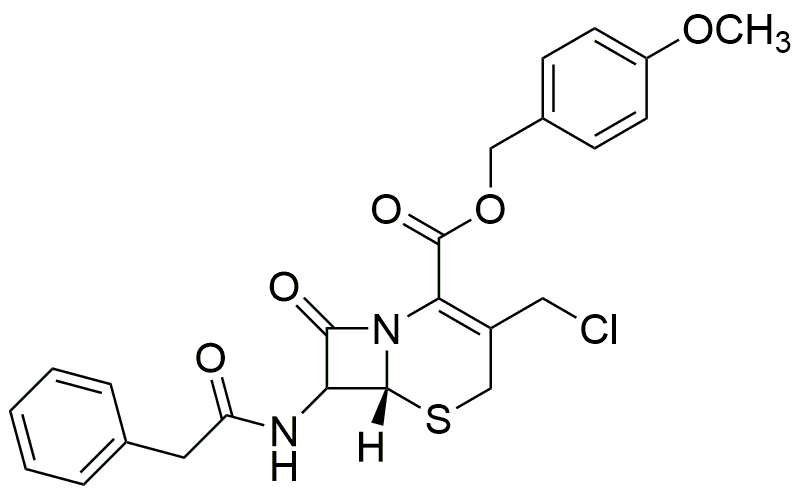4-Methoxybenzyl 3-Chloromethyl-7-(2-phenylacetamido)-3-cephem-4-carboxylate is widely utilized in research focused on:
- Antibiotic Development: This compound serves as a key intermediate in synthesizing cephalosporin antibiotics, which are crucial for treating bacterial infections.
- Pharmaceutical Formulations: It is used in the formulation of drugs, enhancing the efficacy and stability of active ingredients in various therapeutic applications.
- Biochemical Research: Researchers employ this compound to study enzyme interactions and mechanisms, contributing to advancements in drug discovery and development.
- Analytical Chemistry: It acts as a standard in analytical methods, aiding in the quality control of pharmaceutical products and ensuring compliance with regulatory standards.
- Medicinal Chemistry: The compound is explored for its potential in developing new antimicrobial agents, addressing the growing concern of antibiotic resistance.
General Information
Properties
Safety and Regulations
Applications
4-Methoxybenzyl 3-Chloromethyl-7-(2-phenylacetamido)-3-cephem-4-carboxylate is widely utilized in research focused on:
- Antibiotic Development: This compound serves as a key intermediate in synthesizing cephalosporin antibiotics, which are crucial for treating bacterial infections.
- Pharmaceutical Formulations: It is used in the formulation of drugs, enhancing the efficacy and stability of active ingredients in various therapeutic applications.
- Biochemical Research: Researchers employ this compound to study enzyme interactions and mechanisms, contributing to advancements in drug discovery and development.
- Analytical Chemistry: It acts as a standard in analytical methods, aiding in the quality control of pharmaceutical products and ensuring compliance with regulatory standards.
- Medicinal Chemistry: The compound is explored for its potential in developing new antimicrobial agents, addressing the growing concern of antibiotic resistance.
Documents
Safety Data Sheets (SDS)
The SDS provides comprehensive safety information on handling, storage, and disposal of the product.
Product Specification (PS)
The PS provides a comprehensive breakdown of the product’s properties, including chemical composition, physical state, purity, and storage requirements. It also details acceptable quality ranges and the product's intended applications.
Certificates of Analysis (COA)
Search for Certificates of Analysis (COA) by entering the products Lot Number. Lot and Batch Numbers can be found on a product’s label following the words ‘Lot’ or ‘Batch’.
*Catalog Number
*Lot Number
Certificates Of Origin (COO)
This COO confirms the country where the product was manufactured, and also details the materials and components used in it and whether it is derived from natural, synthetic, or other specific sources. This certificate may be required for customs, trade, and regulatory compliance.
*Catalog Number
*Lot Number
Safety Data Sheets (SDS)
The SDS provides comprehensive safety information on handling, storage, and disposal of the product.
DownloadProduct Specification (PS)
The PS provides a comprehensive breakdown of the product’s properties, including chemical composition, physical state, purity, and storage requirements. It also details acceptable quality ranges and the product's intended applications.
DownloadCertificates of Analysis (COA)
Search for Certificates of Analysis (COA) by entering the products Lot Number. Lot and Batch Numbers can be found on a product’s label following the words ‘Lot’ or ‘Batch’.
*Catalog Number
*Lot Number
Certificates Of Origin (COO)
This COO confirms the country where the product was manufactured, and also details the materials and components used in it and whether it is derived from natural, synthetic, or other specific sources. This certificate may be required for customs, trade, and regulatory compliance.


